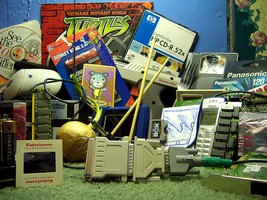Something that is valuable without strings attached has intrinsic value. I find intrinsic value is far more reliable than extrinsic value, because it’s self-reliant, independent, and free of the influence of others. The opposite of intrinsic value is extrinsic value. I like “extrinsic” as a word, but don’t see it used much. What it means is the value is assigned to the item by external forces. The item is worthless on its own. Or perhaps it has a mix of intrinsic and extrinsic value, so it is simply less valuable.
One thing that’s hard to accept about intrinsic vs. extrinsic value is that it’s a sliding scale with different paradigms. Nothing is binary. Something that has intrinsic value in one context and have no value in another. You might think the item has extrinsic value, and from a completely objective perspective it might, but it’s entirely okay to call its value intrinsic for the sake of comparison.
A great example of the two types of value is money. At the extreme end we have currencies made of paper and backed by nothing more than military might. These are called fiat currencies, because they’re valuable by legislative fiat (an order). The United States has fiat currency. My money has no value unless other people agree that it does and will exchange goods or services for it. It cannot be turned in for anything of value (besides coins), more of it can be created at virtually no cost at any time, and if all confidence is lost in it, it doesn’t even make good toilet paper. The money’s value is entirely extrinsic. In fact, it’s declined considerably in my short life. I remember in 2002 when gasoline was 85¢ a gallon, but now it’s over $4. It’s not because of shortages—there’s plenty of higher priced gas available. In terms of fuel, my money is one-fifth as valuable as it was six years ago. Granted, the increased prices are also due to the oil companies joining to form monopolies, but if our money had value that was fully intrinsic, such massive losses would be impossible.
Now, the U.S. dollar has not always been fiat. Before Nixon abandoned the Bretton Woods system in 1971, you could trade in a dollar for 1/35 an ounce of gold. So it had intrinsic value. During the world wars, convertibility was abandoned so more money could be printed, so for a time there was no intrinsic value. But even under Bretton Woods, paper dollars didn’t even have intrinsic value so much as representative intrinsic value. They’re still worth nothing on a deserted island, but as long as we were under the current system of things, their value may as well have been intrinsic, because they could be exchanged for something solid. The value was never fully intrinsic, or else Nixon wouldn’t have been able to pull the plug.
A step up from paper currencies are metal currencies, like the dimes and nickels in your ash trays. Though illegal, in times of panic they can be melted down to build real things, because they’re made of metal, not worthless paper. Gold and silver coins are even better, because people universally value those metals. However, as building materials, they are less valuable. Going back to paper, the bills in my wallet have some intrinsic value I forgot about. If it’s very cold and I need kindling to start a fire, I’ll be happy for my stack of $1’s.
The king of all currencies is gold bullion. It’s never going away, because people universally believe it has value. Its value is unchanging and largely intrinsic. When I see the worth of an ounce of gold is soaring above $1000, I don’t buy the hype that the gold has more value. What’s actually happening is that our dollar is becoming less valuable, but gold is the same as ever. Now, if you can buy more with $1000 of July 2008 money than you could with, say, $500 of July 2001 money, that’s doesn’t mean gold has gained value. It just means everyone is taking losses, by providing goods that are worth more than the money they charge. When the empire (the United States) is dying, everyone takes losses.
Even gold doesn’t have the true, objective type of intrinsic value I talked about at the start. If you’re back on your deserted island, all the gold in the world won’t do nothing to get you out of there. An airplane is something with solid intrinsic value. But you still need fuel, a pilot, and lots of other stuff. Heck, you even have to depend on the laws of physics remaining stable so that it continues working. But most of us would agree that little of its value is extrinsic, so those concerns are small. If all 6.5 billion of us agreed tomorrow that gold is as worthless as water, it would be that way in an instant, though.
Some things have intrinsic value that’s fleeting. The apples at the grocery market are valuable as food, but as soon as they turn rotten, the value is lost. The same can be said for human life: my Grandfather has no intrinsic value, because he’s dead and burned. Nor does my cousin, in spite of being dead and preserved in a coffin. The only value of his body is assigned, because many of us believe in stuffing and preserving corpses for some reason. We believe a corpse has value, but that’s extrinsic to the corpse. A person does have intrinsic value, but only while living. Value shifts from intrinsic to extrinsic upon death. Extrinsic value is not universal, either. My family values my cousin’s corpse much more than my neighbor’s. Extrinsic value can be fleeting. A lottery ticket is valuable extrinsically, but only till the numbers are called. Then it’s worth nothing. If it’s a winner (never happens), the value shoots up all at once, but it’s still extrinsic, just like the coupons in my wallet, because it’s reliant on fulfillment by others. Intrinsic value is not, or in relative cases, it’s reliant on unlikely-to-change entities like society or a humongous government, so it’s always a safer bet.
Where you can use the two types of value in your life, is in analyzing the time and money pits around you. Recognize that if you’re pursuing goals with extrinsic value, your goals belong not to yourself, but to other people. Sometimes, supporting the goals of others is inevitable. Florida Power & Light will cut off my family’s power if we refuse to continue to pay them in extrinsically valuable money. Could we live without power? Probably, but it isn’t practical. I couldn’t even share this writing with you without the power for my computer. Money is something most people value by mandate, despite being extrinsic. It even says on my $1 bill, “this note is legal tender for all debts, public and private,” so I’m required to accept money as a valid form of payment even if I open a business. The business isn’t truly mine if I’m required to give people valuable stuff for in return for crap (fiat money). But I accept that I have no alternative with what power I have now. There’s a massive gulf between this lost freedom and the lost freedom you are probably subjecting yourself to.
One thing that definitely has no intrinsic value is a college degree. A college education has intrinsic value, but only to the person receiving it, and then only if it is applied. A modern college education is utterly worthless. College is a crock. You’re trained to be a docile slave for any master and brainwashed to tell lies as truth to support the state. Lies like global warming, the cancer myth, and politically-correct language. Instead of learning real stuff like history or how to spell, you have to read and write garbage about The Epic of Gilgamesh. It’s worth less than nothing. College saps your mind and spirit. It is a self-accepted prison and you are a self-accepting prisoner. I am currently a prisoner with you, unfortunately.
What a college education does have, is plenty of extrinsic value. Employers, in cahoots with the universities, agree to accept only mind slaves with worthless degrees for jobs. Or perhaps they’ll accept anyone, but pay you much more if you’ve gone through four to six years of obedience school (on top of thirteen years of mandatory training). College is a job where instead of being paid, you pay. Can’t you see the irony there? You learn B.S. subjects like humanities and calculus, wasting upwards of thirty hours a week “studying,” when really you’re just memorizing pointless trivia and useless formulas to reiterate for a test and then forget. A typical collegiate essay is a series of citations, footnotes, references, maybes, “he or she”s, “what if”s, and semicolons. Nothing is from the heart, everything is crap, and no one would read it if they weren’t being paid. There’s no growth and you’re not developing as a person, despite how you may protest. College is at best an expensive social experience, and even that is on shaky ground.
A college education is firmly in the category of extrinsic value. Unlike universal concepts like serving others, inspiration, and passion, and working for yourself, college is ultimately a waste of time. It’s okay to do things with extrinsic value, even if they cost huge amounts of time and money. Repeat after me: “I, Richard X. Thripp, allow myself to pursue projects that have no intrinsic value.” BUT, you cannot live in fear by deluding yourself into believing you’re acting on some higher purpose. There is no higher purpose to my college education. Tasks with only extrinsic value must only be pursued for utilitarian purposes, should you claim to be living courageously.
Buying things that have mere extrinsic value, unless to resell, is something I cannot live with. Diamonds are an example. Unlike gold, they have no intrinsic value because they’re as common as dirt. One company (De Beers) controls all of them, releases very few, and advertises how wonderful and valuable they are. De Beers has managed to make diamonds extrinsically valuable to an insane degree. If you can make yourself (or a product) highly valuable, you can make a lot of money, even if it’s extrinsic.
Intrinsic value is the only path that has a soul, though. In sociological terms, coordinated efficiency (i.e. teamwork) represents intrinsic value, whereas allocated efficiency (i.e. buy the best people) is to extrinsic value. Money has its place: it represents you contribution to the world (either type of value), and it can be exchanged for goods and services of either type (food vs. diamonds). But if you do something for money alone, that means it has only extrinsic value, be it to yourself, the world, or both. With my website, I hope I’m doing something of intrinsic value to others, and I know it has intrinsic value to myself. I take, post, and give away creative photos, write free and hopefully insightful articles, and develop as a person through all of it. If you’re doing something of intrinsic value, you’ll know it because you’re energized, dedicated, and excited about it. If you don’t feel the heat, you might be providing a service that’s intrinsically valuable to others, but not to yourself. If I fixed computers for a living, it would be an important service to others, but it wouldn’t do anything for me. The other thing that can happen, is that you’re doing something you love (intrinsic value for you), but its worthless to others. Perhaps it is painting, playing piano, or taking nature photographs. What you want to do is to find something that’s intrinsically valuable to you and others, or convert what you’re presently doing over. Often, this just involves publishing your art online, or releasing a music album by burning the CDs on your home computer. But when you’re on the path of good for yourself and the world, everything will feel right.
While it takes a lot of soul-searching to reach the goal, I can tell you some of the clues that you’re on the wrong path. If you’re not sharing it with others, it can’t have any value to others. The first step to converting something that’s valuable to you but not to others is to show it to them. If you’ve written an awesome book but can’t find a publisher, just set up a blog and give it away free in installments. Tell a few friends about it. If it’s interesting or useful, lots of people will pick up on it and visit. You’ll know this because you’ll be getting lots of comments and trackbacks, and your bandwidth meter will be maxing out quickly. If this doesn’t happen, it means you suck. It’s okay. Right now I suck. But sucking is the only way to progress.
Once you’ve built you a following and love what you’re writing, you’ve already made it. It doesn’t matter if you’re giving everything away and losing money. If you have a website, and a lot of visitors, it’s impossible not to make money. Then put ads across the site. Register for Amazon Associates too, then start dropping product links everywhere, like this. Soon, you’ll be making money off something that’s intrinsically valuable to everyone, which is great. A lot of people will try to tell you that you can’t do it, you have to pick between money or heart, and that you should keep your day job and just follow your passion on the side. Ignore them and forge ahead.
If you’re working for a corporation with no intrinsic value, it probably puts up a smokescreen of purposeful charity to substitute. Instead of changing the world directly, the company donates a couple percent to charity. This is the “throw money at the problem” mindset, and instead of integrating charitable practices into the business, it’s just tacked on as a “me too” afterthought. Corporations like Wal-Mart, Target, and Publix do this. Then, they’ll come up with some phony mission statement for their employees, like Office Depot’s “delivering winning solutions that inspire worklife.” I couldn’t help but laugh hysterically when I first heard that one. Next, require all the employees to wear shirts with the mission statement and chant it over the intercom.
Ask any candid Office Depot employee if he cares about the mission, and the answer will be an obvious no. Very few people who work there, or have any sort of job, do so for an intrinsically valuable purpose. “For the greater good of all humanity” is an excellent purpose, but most companies that bandy it about don’t believe it. It is of extrinsic value to them. It’s fake, a charade to fool dummies and investors. You’re never living intrinsically if you’re living fakely. It’s better to work for a company with the mission, “to make the most money possible, at all costs.” Or live your life like it. But that’s a petty experience. Most companies are not that bad. They have a decent amount of respect for their customers and employees. But to call themselves charity cases is false and pretentious.
What else is only of extrinsic value? Certification. Education. Expensive clothes (unless radiation proof). Rites of passage. Careers. Tradition. Rules and procedures. Legacies. Religion. Sleeping at night. Clocks. Being an employee. Corpses. Funerals. All these have no value on their own. Only if other people agree, or demand them, do they become valuable, and then only extrinsically. Don’t be too worried about them. They’re red herrings.
What things do have intrinsic value? Love. Doing what you love. Purpose. Learning. Passion. Discipline. Wealth (for leverage). Power (the power to know better). Respect for human life. Serving others. Serving yourself (you have to to serve others). The list goes on, but you can see that aligning yourself with these principles, and paying no attention to the ones of extrinsic value will alienate a lot of would-be friends. Do it anyway.













